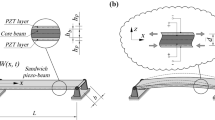Abstract
In this paper, the piezoelectric compensation of torsional vibrations in rods caused by external excitations is studied. As an illustrative example, a laminated rod containing piezoelectric shear actuators is assumed to be fixed at the one end, and the other end is subjected to a torsional couple; additionally, a distributed torsional couple per unit length is acting. In such a system, cross-sectional warping is known to be present. The consideration of piezoelectric eigenstrains requires an extension of Saint Venant’s theory of torsion, which is achieved by introducing an additional warping function. Using D’Alembert’s principle, the boundary value problems for Saint Venant’s warping function, the additional warping function and the torsional angle are obtained. From the latter boundary value problems, the distribution of piezoelectric actuation is derived in order to completely compensate the external excitations, i.e. an analytical solution of the corresponding shape control problem is obtained. Finally, the results are verified by means of three-dimensional finite element computations.
Similar content being viewed by others
References
Walker D.N.: Torsional Vibrations of Turbo-Machinery. McGraw-Hill, New York (2004)
Ye S., Williams K.A.: Torsional friction damper optimization. J. Sound Vib. 294, 529–546 (2006)
Nayfeh S.A., Varanasi K.K.: A model for the damping of torsional vibration in thin-walled tubes with constrained viscoelastic layers. J. Sound Vib. 278, 825–846 (2004)
Kappler M., Böhme G., Müller A.: Numerical study on the nonlinear oscillations of a torsion absorber filled with a viscoelastic fluid. Acta Mech. 173, 195–206 (2004)
Chopra I.: Review of state of art of smart structures and integrated systems. AIAA J. 11, 2145–2187 (2002)
Crawley E.: Intelligent structures for aerospace: a technology overview and assessment. AIAA J. 8, 1689–1699 (1994)
Sunar M., Rao S.S.: Recent advances in sensing and control of flexible structures via piezoelectric materials technology. Appl. Mech. Rev. 1, 1–16 (1999)
Mason W.P.: Piezoelectricity, its history and applications. J. Acoust. Soc. Am. 70(6), 1561–1566 (1981)
Yang J.: An Introduction to the Theory of Piezoelectricity. Springer, New York (2005)
Mura T.: Micromechanics of Defects in Solids, 2nd edn. Kluwer, Dordrecht (1991)
Irschik H., Pichler U.: An extension of Neumann’s method for shape control of force-induced elastic vibrations by eigenstrains. Int. J. Solids Struct. 41, 871–884 (2004)
Adam C.: Eigenstrain induced vibrations of composite plates. Acta Mech. 148, 35–53 (2001)
Takawa T., Fukada T., Takada T.: Flexural-torsion coupling vibration control of fiber composite cantilevered beam by using piezoceramic actuators. Smart Mater. Struct. 6, 477–484 (1997)
Park C., Chopra I.: Modelling piezoceramic actuation of beams in torsion. AIAA J. 34, 2582–2589 (1996)
Park C., Walz C., Chopra I.: Bending and torsion models of beams with induced-strain actuators. Smart Mater. Struct. 5, 98–113 (1996)
Spearritt D.J., Asokanthan S.F.: Torsional vibration control of a flexible beam using laminated PVDF actuators. J. Sound Vib. 193, 941–956 (1996)
Shen I.Y., Guo W., Pao Y.C.: Torsional vibration control of a shaft through active constrained layer damping treatments. J. Vib. Acoust. 119, 504–511 (1997)
Chandra R., Chopra I.: Structural modelling of composite beams with induced-strain actuators. AIAA J. 31, 1692–1701 (1993)
Zhu M., Lee S.R., Li H., Zhang T., Tong P.: Modelling of torsional vibration induced by extension-twisting coupling of anisotropic composite laminates with piezoelectric actuators. Smart Mater. Struct. 11, 55–62 (2002)
Sung C., Varadan V.V., Bao X., Varadan V.K.: Active torsional vibration control experiments using shear-type piezoceramic sensors and actuators. J. Intel. Mat. Syst. Str. 3, 436–442 (1994)
Centolanza L.R., Smith E.C., Munsky B.: Induced-shear piezoelectric actuators for rotor blade trailing edge flaps. Smart Mater. Struct. 11, 24–35 (2002)
Zehetner, Ch.: Compensation of torsion in rods by piezoelectric actuation. Arch. Appl. Mech. doi:10.1007/s00419-008-0204-y (2008)
Savoia M., Tullini N.: Torsional response of inhomogenous and multilayered composite beams. Compos. Struct. 25, 587–594 (1993)
Swanson S.R.: Torsion of laminated rectangular rods. Compos. Struct. 42, 23–31 (1998)
Tanghe-Carrier F.: A remarkable property of the Saint-Venant warping function for orthotropic composite beams. Mech. Res. Commun. 27, 143–148 (2000)
Rand O., Rovenski V.: Analytical methods in anisotropic elasticity. Birkhäuser, Boston (2005)
Haftka R.T., Adelman H.M.: An analytical investigation of shape control of large space structures by applied temperatures. AIAA J. 23, 450–457 (1985)
Irschik H.: A review on static and dynamic shape control of structures by piezoelectric actuation. Eng. Struct. 24, 5–11 (2002)
Irschik H., Krommer M., Pichler U.: Dynamic shape control of beam-type structures by piezoelectric actuation and sensing. Int. J. Appl. Electrom. 17, 251–258 (2003)
Zehetner Ch., Irschik H.: Displacement compensation of beam vibrations caused by rigidbody motions. Smart Mater. Struct. 14, 862–868 (2005)
Zehetner, Ch.: Piezoelectric compensation of flexural and torsional vibrations in beams performing rigid-body motions. Doctoral Thesis, Johannes Kepler University of Linz (2005)
Ziegler F.: Mechanics of solids and fluids. Spinger, New York (1998)
Washizu K.: Variational methods in elasticity and plasticity. Pergamon Press, Oxford (1974)
Di Paola M., Pirrotta A., Santoro R.: Line element-less method (LEM) for beam torsion solution (truly no-mesh method). Acta Mech. 195, 349–364 (2008)
Author information
Authors and Affiliations
Corresponding author
Rights and permissions
About this article
Cite this article
Zehetner, C. Compensation of torsional vibrations in rods by piezoelectric actuation. Acta Mech 207, 121–133 (2009). https://doi.org/10.1007/s00707-008-0112-9
Received:
Revised:
Published:
Issue Date:
DOI: https://doi.org/10.1007/s00707-008-0112-9




